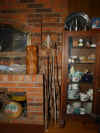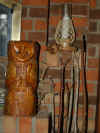| 03-15-04
To this point March has been more lion than lamb, but if form prevails
we will be hearing reports of morel mushroom finds before the month fades
into April.
Hoosier morellers--ye olde editor included--have a bent for starting
the quest for spring morels days (even weeks) before conditions are right.
But this is not all bad for a number of reasons, the most important of
which being that these dry runs offer a chance for selecting just the right
mushroom stick.
A mushroom stick is not a must for successful morel hunting. But such
a "tool" will save many a crick in the back by uncovering items like pieces
of corn cob, sycamore balls, and simple air pockets under dry leaves that
could be morels but aren't.
Then, of course, there is the deep-rooted kinship that can develop between
the mushroom master and his "stick."
Frankly, I have never owned a mushroom stick that confessed a pure and
abiding love for me, but I have always assumed that this shortcoming of
appreciation has been thwarted only by the fact that the vocabulary of
mushroom sticks is quite limited--like: "Flip that big sycamore leaf over,
boss; there may be a little gray hiding under there."
I might add that when mushroom sticks go out on a limb to predict such
possibilities, they usually are wrong. But I give them an "A" for effort.
Mushroom sticks have many physical characteristics. They are long and
slim, short and strong, with or without forks at the terminus, and green
or dry, not to mention other attributes. Thus, there are many decisions
to be made in selecting just the right stick.
The green-versus-dry issue is always a dilemma for me. I figure a green
stick is more sturdy, but this option entails ending the life of an innocent
seedling. However, not to be overlooked in going green is the bark that
offers a chance to do some fancy monogramming during rest stops in the
woods, when your wife is vainly trying to get you to plant the flowers
she bought at the store, and other times.
Frankly, I like a dead sticks because they are lighter. But dead sticks
are greater breakage risks, and everyone knows a broken stick in a half-picked
patch of morels can be disastrous.
Green sticks certainly are more durable. If a small-diameter seedling
can be located, the weight factor is minimized.
I also see a terminal fork as a must. You never know when you might
want to pin a copperhead, or some other critter, to the earth to get a
better look at him.
No matter how you go in selecting a mushroom stick, the thing to remember
is that you are taking this stick for better or worse . . . It will be
your constant companion at least for this year, perhaps years to come.
I have a tendency to take a new stick with each new morel season. I
save the old sticks, stacking them neatly (long-gun style) in a peaceful
little nook between the elevated dining room fireplace and a China cabinet.
It seems to be a good spot--I enjoy looking at my collection on cold winter
nights when my wife says I have a "far-away" look in my eyes. It seems
like a good spot until someone, who looks less kindly than I on things
like old mushroom sticks, quietly thins the ranks by turning a few into
kindling . . . an inherent weakness of the location.
When we have company for dinner and I have done my mushroom-stick routine,
somebody always asks: "Which one is your favorite?"
"They're all my favorites," I say with a smile, "if they weren't, they
wouldn't be there."
Click on thumbnail photo for enlarged view.
 |
 |
| I
stack my sticks, long-gun style in a pleasant little nook between the elevated
dining room fireplace and a China cabinet. |
Closeup
of my sticks in their niche. |
PUBLIC MEETINGS--For
the past six months, a 10-member group comprised of Indiana deer farmers,
hunting preserve owners and conservationists have studied the controversial
subjects of regulating white-tailed deer ranching and hunting of deer and
elk within fenced enclosures in Indiana.
Now the group is ready to put its findings before the public at four
meetings scheduled for this month and April.
Known as the Citizens Advisory Council on Captive Cervids (CACCC), the
group has developed recommendations for how Indiana should regulate deer
and elk in captivity.
The series of recommendations address rehabilitation of white-tailed
deer, cervids as pets, regulatory functions of the DNR and Indiana Board
of Animal Health, and hunting of cervids within high-fenced enclosures.
However, to this point the panel has not agreed on issues of hunting
deer in fenced areas should be handled.
The four meetings will give the public an opportunity to express their
views on all facets of the group's deliberations, including hunting deer
in fenced areas.
The schedule of meetings follows:
March 19, 2-7 p.m. at Vincennes, Executive Inn, 1 Executive Boulevard;
March 20, 2-7 p.m. at Seymour, Holiday Inn, US 50 & I 65;
April 2, 2-7 p.m. at Fort Wayne, Best Western Motel, I 69 & SR
24 (Exit 102);
April 3, 2-7 p.m. at West Lafayette, Hilton Garden Inn, 356 East States
Street.
A complete listing of the advisory council's recommendations is available
at: http://www.in.gov/dnr/cervidcouncil/resolutions.html
Information about CACCC (including notes from each of the group's eight
meetings) is available at http://www.in.gov/dnr/cervidcouncil
|

